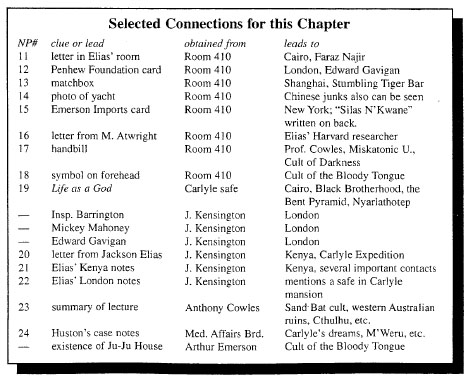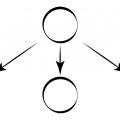One of the challenges a GM faces is in presenting the complex reality of a living world: Players have the luxury of focusing on a single character, but the GM often finds themselves needing to juggle dozens of characters and potentially hundreds of pieces of information.
One of the most important skills for a GM to master, therefore, is better organization.
Take a dungeon, for example. Simple stuff like using a numbered key to describe the dungeon may seem obvious, but take a second to imagine the alternative where that basic level of organization isn’t applied. (And I have, in fact, seen published adventures where it wasn’t applied. It isn’t pretty.)
Now, how could we improve that organization even more? Well, we could start by clearly segregating “information anyone entering the room should immediately know” from “information that can only be gained with further investigation”. (Properly written boxed text is one way of doing that, of course.)
Might it be useful to also distinguish “information characters might notice immediately upon entering the room without taking any particular action”? Probably.
And so forth.
Note that I’m not talking about performing any extra prep work. I’m just talking about organizing your prep work so that it’s easier to use at the table. (I’ve actually found that proper organization can actually reduce the amount of prep you need to do.)
The node-based structure itself, of course, is one way of organizing your prep work. In terms of organizing the actual nodes, though, here are a few tips that I’ve learned—
KEY YOUR NODES: Just like the rooms in a dungeon, it will be easier to reference and use your nodes if you key them. For the most part, I just use numerical codes: Node 1 is First Central Bank. Node 2 is the security guard who didn’t show up for work during the robbery. Node 3 is the stolen car that was used as a get-away vehicle. And so forth.
KEEP A CONNECTION LIST: I’ve talked in the past about the importance that The Masks of Nyarlathotep played in developing the Three Clue Rule and, by extension, node-based scenario design. The concept of a “connection list” is taken directly from that campaign:

It shouldn’t take much imagination to see how much easier such a list will be to design and maintain if you’ve specifically keyed your nodes. I discuss this concept at much greater length in Using Revelation Lists.
KNOW YOUR NODE HIERARCHY: At a basic level, you should have some rough sense of how you want the various nodes of the scenario to hook up. (Bearing in mind that (a) your players will probably find all kinds of ways to connect the nodes that you never intended and (b) you don’t really need to pursue some sort of rigid ideal.
And if you’re dealing with a relatively small number of nodes, that’s probably all you need to know. But as the number of nodes begins to grow, you’ll probably find it useful to break them up into more manageable packets: Can you break one large scenario into multiple smaller scenarios?
Those scenarios, of course, can hook into each other. But by breaking them up into distinct packets, I find it’s easier to keep the overall structure of the campaign manageable and comprehensible.
For my games, I typically maintain a document I refer to as the “Adventure Track” which details the macro-level node structure of the campaign. For my Ptolus campaign, I broke the macro-structure into five acts. And then, within each act, I created clusters of related nodes using a simple outline structure.
For example, here’s Act I:
1. The Awakening
2. The Murderer’s Trail (Ptolus – Adventure #1)
a. Following the Ledger
b. House of Demassac
c. Jirraith and the Pale Dogs
3. The Trouble With Goblins (Ptolus – Interlude #1)
a. Complex of Zombies
b. Laboratory of the Beast
c. Goblin Caverns of the Ooze Lord
4. Smuggler’s Daughter (Ptolus – Adventure #2)
a. The Slavers’ Enclave
5. End of the Trail (Ptolus – Adventure #3)
a. Swords of Ptolus
b. Cloud Theater
6. Shilukar’s Lair (Ptolus – Adventure #4)enture #4)
Each line here is a major scenario, with the various scenarios interconnected as nodes. (Some of these individual scenarios are also designed using node-based techniques.) The indented lines are closely associated with the “major nodes” above them. (In other words, I’m using a basic outline structure to conveniently group the content of Act I into convenient conceptual packages. This outline also keys each node: “The Awakening” is Node 1; “Laboratory of the Beast” is Node 3B; and so forth.)
Act II of the campaign is even more complicated, featuring a total of 42 major scenarios. In order to keep the structure of that act manageable, I broke it down into three semi-independent “chunks”, each of which was then organized in a fashion similar to the outline for Act I you see above.
I’ve found this Adventure Track + Connection List method to be very useful for both preparing and running a node-based campaign. But there’s nothing magical about it. You should find the method that works best for you. My general point, however, is that you should strive to achieve a high-level understanding of your node structure – chunking that node structure into larger and more manageable pieces as necessary.














Hi Justin,
i’m literally eating your posts dude!
Thanks, i think i can use it to create some quest for my friends envolving investigation, i’m mixing your ideas with some others like The Butler Did It: Mystery Plotlines in RPGs from campaignmastery.com and some information from The Night’s Black Agents from Pelgrane, like conspyramid and more. Again, thanks, if i have some idea i’ll be glad to share with you.
For now, your example for Act I has a white font, is not visible.
See you later!
Ok, ok! i’m dumb!
i just read it now.
“(I’ve rendered this as white text because it has minor spoilers for my current players. If you’re not one of my players, just highlight the text to read it.)”
[…] – Organización: normalmente, el DJ tiene la difícil labor de tener organizado el mundo en el que se mueven los personajes con una cantidad de tiempo propio limitada, y una comprensión finita. Algunos trucos y mecanismos para facilitar este proceso en el “Sistema de Nodos” son: Identificación: es necesario tener identificado cada nodo de forma inequívoca para no confundirlo con otro cuando tengamos un gran número de conexiones. Lista de conexiones: una vez ya tenemos una lista clara e inequívoca de nodos y de aquellos con los que conectan, para poder tener una referencia rápida en la partida. Comprensión de la estructura narrativa: no es necesario conocer de memoria la lista de conexiones de los diferentes nodos (que para eso tenemos la lista), pero sí una idea general tanto de la estructura que forman como si pueden agruparse para formar sub-escenarios y creando una macro-estructura para refrescar en nuestra mente la estructura con un simple vistazo. (Recomiendo echar un vistazo en el link original). […]
Love your stuff. It’s been helping me out a ton planning my first campaign.
Are there any software tools you know of that lend themselves to the three clue rule, visual node based scenario design, and connection lists? I use note taking software like Evernote and OneNote but they are imperfect solutions at best. Maybe something like Realm Works?
Great post! Do you plan all those node structures and arcs ahead of time? Or do you just create an overview of the campaign (as you expect it to happen) and change it acoording to the player’s decisions?
Little of column A; little of column B.
Let me use my Ptolus campaign as an example.
For Act I, I prepped a list of nodes and also the revelation list that would connect those nodes together. (You can see some similar work detailed in Part 3C of the Avernus Remix.) But I didn’t actually prep all the individual nodes. In fact, some of those nodes never got detailed because the PCs didn’t follow those leads.
On the flip side, it’s not unusual for the actions of the PCs to create new nodes by essentially following leads that I didn’t realize were leads (or creating leads out of whole cloth). I discuss one example of this from the Ptolus campaign here.
You can see something similar in my Eternal Lies Remix: Eternal Lies was a published campaign and all the nodes were laid out and fully detailed. The players, however, chose to go to both the Severn Valley and Axum by following information that wasn’t explicitly designed as a lead, but which they nevertheless interpreted as such.
As the GM, I’ll also proactively create new nodes that arise logically out of the evolving circumstances of the game. The Shipwrights’ Ball in my Dragon Heist campaign is an example of that.
Sorry if this is my own misreading confusing me, but is this idea of a Connection List, just the precursor to the Revelation List?
More recently, after making a connection list, would you just create a Revelation list in tandem as your Living Adventure Track Document evolves, Never really getting rid of either?
To me the use of a connection list seems like the better tool when designing this macro Node-Structure, as it tells you what other clues you need to include when fully designing a Scenario, however the revelation list seems just as important to avoid forgetting prior established clues as well as tracking whether or not your players will ever encounter a Scenario at all?
Sorry again, if this is just my own misunderstanding.
@Alex: Yup! You’ve got it. I generally drop the connection list (which I now refer to as a clue list) after using it to design the scenario because it’s not as useful as the revelation list during actual play.
I break down this process in much more detail in Using Revelation Lists.
Hey Justin! Loving the book!
I don’t know if this is from me interpreting the text wrong or something like that, but when making a Adventure Track does it fit all the clues within itself? For example can 3.b Laboratory of the Beast only contain clues for this act’s nodes or can it have clues leading to other act’s nodes?
@Licorice: You can 100% have them point to other acts, other campaigns, unrelated side quests, or literally anything you want them to point to.
The concept of “Act” here was just a useful way for me to organize this specific campaign.
For reasons described here, this particular campaign had a deliberate firewall because Act II would have a separate trigger from the node-based structure, but there were actually still clues in Act I that could be followed into Act II: Shilukar’s Lair, notably, included leads to the Temple of Deep Chaos and the Temple of the Rat God, which were both Act II scenarios.